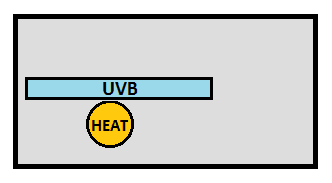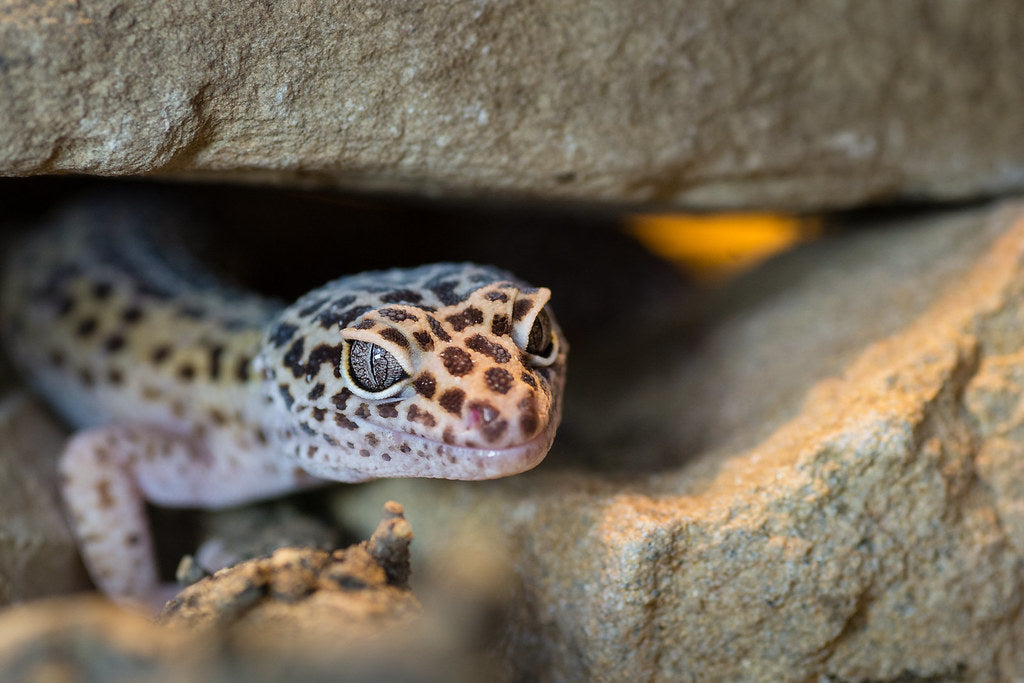If you’re planning on getting a pet leopard gecko, then the first thing you need to do is set up an appropriate terrarium for it to live in. Leopard geckos aren’t like other types of pets that you may be more familiar with, such as dogs or cats. They can’t simply live free-range with you in your home; instead, they need a terrarium that has the right equipment in the right arrangement to create a usable environment that replicates the conditions of their native habitat.
If you haven’t read our Leopard Gecko Care Sheet yet, read that first! Once you have a basic understanding of what your new pet needs from its habitat, you’re ready to start setting up a leopard gecko terrarium.
It may seem expensive to buy all of these supplies for a little lizard, but they are essential to your pet’s survival. Without an appropriate terrarium to live in, your new pet is likely to get sick and die. Here’s our step-by-step guide to successfully setting up a leopard gecko terrarium so you and your beloved pet can enjoy many years together!
Step 1: Choose the Right Terrarium
Leopard geckos are terrestrial and generally grow to 8-10” long, and need a terrarium that is appropriately sized not only for their length, but their behaviors and level of activity. 36”L x 18”W x 16”H is considered the minimum, but larger, such as 48”L x 24”W x 24”H, is better.
This terrarium can be made from wood, PVC, or glass, but it should be front-opening and have plenty of ventilation for healthy airflow, whether in the form of a mesh top or side vents. We prefer enclosures with a mesh top design, as they make it much easier to safely install heat and UVB lamps.
If your terrarium doesn’t have opaque sides, you will need to cover them with something to help your leopard gecko be comfortable in its environment. This can be as simple as construction paper or as elaborate as a 3D textured background.
Step 2: Arrange Your Lighting and Heating Equipment

To heat and light your leopard gecko’s terrarium appropriately, you will need the following equipment:
- Heat lamps (at least 2)
- UVB lamp
- Hide box/cave
- Heat mat
- On/off thermostat
Both heat lamps should be placed on the right or left side of the terrarium, close together. The UVB lamp should be placed on the same side so it fully overlaps with the beams from the heat lamps.
Leopard geckos are nocturnal, which means they are most active at night. This also means that it’s best practice to provide a warm hide for them to use when they want to be warm but don’t feel like basking in the open. Simply place a hide directly underneath the heat lamps, and if the heat lamps don’t get it to 90-92°F, even though the basking temperature is within range, add a heat mat connected to a thermostat under the hide, hidden under a 1-2” layer of substrate. To be effective, the thermostat probe must be placed inside the warm hide.
Products we recommend:
- Fluker's Mini Sun Dome Lamp, 5.5"
- Zoo Med Repti Tuff Splashproof Halogen Lamp, 50w
- Arcadia T5 HO Forest 6% UVB bulb, 22”
- Arcadia ProT5 Lamp Fixture, 24”
- Exo Terra Gecko Cave, Large
- Zoo Med ReptiTherm Under Tank Heater (U.T.H.), Small
- Exo Terra Thermostat, 100w
Step 3: Start Minimalist
With any new pet reptile, it is best practice to quarantine them for 3-6 months after bringing them home, especially if you have other pet reptiles. When you first set up your leopard gecko terrarium, it’s best to start simple so you can quarantine them efficiently.
Here’s what you need at minimum:
- paper towels for substrate
- sphagnum moss
- hide box or cave (at least 2)
- small water dish
- digital thermometer/hygrometer device (x2)
UVB wavelength intensity increases the closer your gecko gets to the lamp. If at all possible, buy or borrow a Solarmeter 6.5 to check that the maximum UVI is no higher than 4.0. Generally speaking, this means that the gecko should not be able to get closer than 13” under the bulb if the lamp is mounted over mesh.
Place the thermometer probes so one is in the warm hide and one is on the cool side of the terrarium. Your temperature gradient should look like this:
- Basking surface temperature: 94-97°F
- Warm hide temperature: 90-92°F
- Cool side temperature: 70-77°F
- Nighttime temperature: 60-72°F
If temperatures are too high, use a plug-in lamp dimmer, thermostat, or a lower bulb wattage. If the temperatures are too low, you will need higher-wattage bulbs.
For humidity, provide a moist hide. This can be done by placing a hide box on the cool side of the enclosure lined with moistened sphagnum moss. The moss will need to be routinely replaced and remoistened.
Products we recommend:
- Galapagos Blond Sphagnum Moss, 150 in³
- Exo Terra Mister
- Zoo Med Repti Rock Corner Bowl, Large
- Exo Terra Ficus Silk Plant, Large (x2)
- Galapagos Walking Wood Grapevine Branch Brown 19 In - 24 in
- Zoo Med Digital Combo Thermometer Humidity Gauge (x2)
Step 4: Quarantine for at Least 3 Months
The purpose of using a minimalist setup for quarantine is to make it easy to keep clean. During this time, monitor your leopard gecko for signs of parasites or illness. If you notice anything concerning, take it to an experienced reptile veterinarian for diagnosis and treatment.
Substrate should be changed out whenever it gets soiled, and the enclosure and all accessories should be disinfected at least 1x/month. Use a bleach solution (¾ cup bleach per gallon of water) or veterinary-grade disinfectants like F10SC and Clean Break.
Step 5: Add Substrate
Once quarantine is over, you can work on giving your leopard gecko’s terrarium a fully-enriched, long-term layout. It won’t need to be cleaned quite as often — only once every 3-6 months, depending on how good you are about spot-cleaning.
The first step of setting up a long-term terrarium design is adding a naturalistic substrate. For a leopard gecko, it’s best to use fine sand or sandy soil. You will need at least 4” of substrate to encourage natural burrowing behaviors, so for a 36”x18”’ terrarium, count on at least 34 quarts or 1 cubic foot of substrate.
If your terrarium has different dimensions, you can estimate the amount of substrate you’ll need by multiplying the length x width to get the number of cubic inches of substrate it will take for 1” deep of substrate. Then multiply that number by the desired depth of substrate, then convert the resulting number to quarts or cubic feet.
Products we recommend (choose one):
- Zoo Med ReptiSand
- Exo Terra Desert Sand
Step 6: Add Environmental Enrichment
Environmental enrichment is the process of strategically adding items to your gecko’s terrarium that make it more functional for the occupant. Now it’s time to get creative! The best way to get inspiration for your terrarium’s appearance is by looking at pictures of leopard gecko habitat on sites like iNaturalist and Flickr.
Place the water bowl and hides first, then build around those. Make sure the water bowl is accessible and easy to remove, but there should still be plenty of hiding places, climbing opportunities, and cover to encourage your gecko to explore while helping it feel secure in its home.
Rocks
Stacked flagstones make attractive and highly functional decor, providing places for your gecko to climb and hide. However, make sure to glue them together with cement or silicone so they don’t collapse and accidentally crush or injure your pet!
Ledges
Magnetic ledges offer great lookout points for leopard geckos to survey their surroundings, and encourage climbing.
You don’t have to worry too much about mold in the semi-arid environment of a leopard gecko terrarium, so your options for wood are pretty broad. Mopani wood, cork bark, grape vine, cholla wood, and manzanita wood can all work. Whichever you choose, make sure the branches are large enough to support your lizard’s size, and low enough to the ground that it can’t fall too far.
Plants are a great way to make a leopard gecko enclosure more attractive, whether real or fake.
Live plants should be kept in pots to help keep the water close to the roots, unless the enclosure is bioactive (which this article is not covering). Use drought-tolerant plants tolerant of higher ambient temperatures and moderate to high amounts of light. They should also be nontoxic, in case your lizard eats a bug that nibbled on one of the plants. Some suitable options include:
- Agave
- Aloe
- Carex grass
- Elephant bush
- Festuca grass
- Gasteria
- Haworthia
- Hens and chicks (Echeveria)
- Ice Plant
- Jade plant (Crassula ovata)
- Prickly pear cactus (Opuntia danicolor) (spineless)
- Sempervivum
For more safe plant ideas, visit The Tortoise Table.
Conclusion
Even after you’ve set up your leopard gecko’s long-term terrarium arrangement, it’s okay to rearrange it every so often as you come to understand leopard gecko husbandry better. It also helps keep your pet’s environment “fresh” and stimulates them to explore and exercise!
"Leopard Gecko" by Chris! Würbel is licensed under Creative Commons











